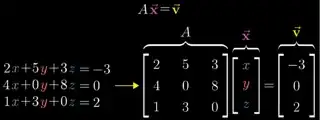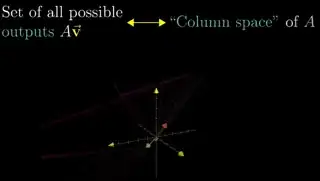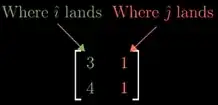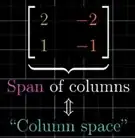I am learning linear algebra from 3b1b series.
At this point, he explains for what he is using variables $A, \vec{x}$ and $\vec{y}$:
Then at here, he says:
he further says following:
Set of all possible outputs of matrix, whether it’s a line, a plane or a 3D space, whatever, is called the column space of your matrix. The column of matrix tell whether the basis vectors land:
P2: Span of those transformed basis vectors gives all possible outputs.
P3: In other words, the column space is the span of the columns of your matrix.
(Note that all above $2\times 2$ matrices are different examples of $A$.) Now the author of videos has taken unit direction vectors as basis throughout his videos:
$\hat{i} = \begin{bmatrix}
1 \\
0 \\
0
\end{bmatrix},
\hat{j} = \begin{bmatrix}
0 \\
1 \\
0
\end{bmatrix},
\hat{k} = \begin{bmatrix}
0 \\
0 \\
1
\end{bmatrix}
$
So to get corresponding tranformed vectors, we will put $\vec{x}=\hat{i},\vec{x}=\hat{j}$ and $\vec{x}=\hat{k}$ in $A\vec{x}=\vec{y}$
Lets say we get,
$A\hat{i}=\vec{I}$,
$A\hat{j}=\vec{J}$,
$A\hat{k}=\vec{K}$
Then, I feel its set of all vectors obtained by linear combinations of $\vec{I},\vec{J}$ and $\vec{K}$ is called column space of $A$. That is,
P4: column space $=\{\vec{V}|\vec{V}=c_1\vec{I}+c_2\vec{J}+c_3\vec{K}\}$
Q1. Am I correct with above?
Q2. If yes is answer to Q1, then how $\{\vec{V} | ..\}$ in P4 is same as $A\vec{v}$ in P1? Specifically, P4 does not involve $A$, but P1 does involve $A$ (,though I can understand $\vec{V}$ is somewhat same as / related to $\vec{v}$).
Q3. Geometrically $A$ defines a transformation. Then why it calls "Column space of $A$" in P1 and "span of the columns of your matrix" in P3, when as per P4 (if at all P4 is correct), column space is a space formed by linear combination of $\vec{I},\vec{J}$ and $\vec{K}$?
Q4. My general understanding about column space, after reading various definitions online, is that its a set of all vectors (range or image) obtained by applying $A$ to all vectors in given/current vector space (domain). Thus it is range / image of function defined by transformation $A$. Am I correct with this?



